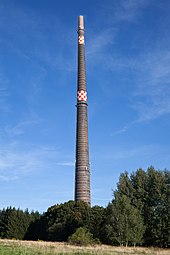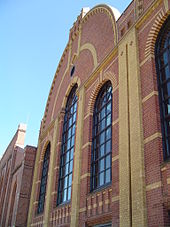Industrial monument
An industrial monument is understood to be an industrial facility that is classified as a monument in terms of monument conservation, i.e. as a testimony to past cultural history , and can be protected as a historical monument . As a technical monument, it is intended to keep the memory of the history of industry alive , especially in the 19th and 20th centuries ( industrialization ).

On the concept of the industrial monument
In the course of the structural change in the heavy industry and the coal and steel industry after the Second World War, industrial history as a cultural achievement worth protecting - beyond the purely aesthetic value of engineering - moved into the focus of monument preservation. In 1968 the Ironbridge Gorge Museum Trust industrial park ( Coalbrookdale and Ironbridge in Shropshire) in the English Severn Valley was placed under protection, a milestone in industrial archeology . In 1984 the term industrial heritage was recognized by the Council of Europe .
Many regions of Europe have a large number of industrial monuments with an industrial architecture typical of the time, for example the Ruhr area and the Saarland with witnesses of the mining industry, the Chemnitz - Zwickau area, which is very much characterized by mechanical engineering and vehicle construction , Catalonia , northern England , eastern France and northern Italy with textile and engineering industry. Many industrial monuments were also preserved in Germany in the course of the Emscher Park International Building Exhibition (1989–1999). In the recent past, both the concept of the industrial landscape as an industrial ensemble and evidence of the early industrial trade of the 17th and 18th centuries have moved up into the group of listed industrial objects.
Protected industrial plants are often already out of operation. Industrial monuments are therefore often used as museums or for exhibition and event purposes (see also conversion of old halls ). As far as they are privately owned, they are hardly accessible to the public.
Examples of industrial monuments



See also: Route of Industrial Culture , Route of Industrial Culture Rhine-Main , List of listed industrial buildings in Radebeul , LWL Open-Air Museum Hagen , LWL Industrial Museum , LVR Industrial Museum
Mining and coal industry
- Völklinger Hütte
- Zeche Zollern II / IV in Dortmund - the first industrial monument in North Rhine-Westphalia
- Hansa coking plant in Dortmund
- Zeche Zollverein in Essen - World Heritage Site
- Henrichshütte Hattingen
- Landscape Park Duisburg-Nord - former iron and steel works
- Ferropolis near Bitterfeld - former open- cast brown coal mine
- Malakoff towers - winding towers of the mining industry in the 19th century
- Messinghof (Kassel)
- Styrian Erzberg
- Braubach lead and silver smelter
- German Salt Museum - industrial monument Saline Lüneburg
Mechanical engineering and vehicle construction
- Volkswagen plant Wolfsburg (partially)
- Chemnitz Industrial Museum
- Industrial Museum Lauf
- Behrensbau in Berlin-Oberschöneweide
Building materials industry
- Hoffmann ring furnace in the Glindow brickworks museum
- Mildenberg brickworks park
- Lime funnel furnace Wuppertal
Textile industry
Defense industry
power supply
- Gasometer z. B. the Gasometer Oberhausen , Gasometer Vienna , Gasometer Berlin-Schöneberg , Gasometer Zwickau or the gas works in Augsburg , Duisburg , Münster
- Walchensee power plant in Kochel am See - fully operational
- Heimbach power plant in Heimbach (Eifel) - Art Nouveau power plant
- Koepchenwerk in Herdecke - former hydroelectric power station
- Zschornewitz power plant
- Faal power plant
Inland shipping
- Inner harbor in Duisburg - former industrial harbor
- Henrichenburg ship lift in Waltrop
- Niederfinow boat lift on the Oder-Havel Canal in Brandenburg
brewery
- Bottle tower of the former Engelhardt brewery in Berlin
- Landskron brewery in Görlitz
- Brewery & distillery Gebrüder Sünner in Cologne-Kalk
- Old malt house in Regensburg
- Malt factory G. Naefeke, since 1996 stilwerk Hamburg
Radio technology
- SAQ machine transmitter in Grimeton
- Transmitter Königs Wusterhausen
- Radom raising
Food economy
- Uetersen farmer's mill
- Ice cream factory in Berlin-Mitte
- Palm kernel oil storage in Berlin-Stralau
- Lehndorf rye mill in Braunschweig
- Sugar factory Oldisleben in Oldisleben ( Thuringia )
photos
Industrial buildings AEG on the banks of the Spree , view from Berlin-Niederschöneweide
See also
- Industrial museum , industrial archeology
- Industrial architecture , industrial construction
- The International Committee for the Conservation of the Industrial Heritage
- List of technical monuments in Germany
literature
- Initiative Völklinger Hütte (publisher): Die Völklinger Hütte , Sutton Verlag, Erfurt 2008.
- James Douet: Industrial Heritage Re-tooled - The TICCIH guide to Industrial Heritage Conservation . Carnegie, Lancaster 2012. ISBN 978-1-85936-218-1 .
- Hubert Krins, Michael Goer, Leo Schmidt : bridge, mill and factory. Technical cultural monuments in Baden-Württemberg . Theiss publishing house. 1991. ISBN 3-8062-0841-7 .
- Claus Militz, Werner Rudolph: Traces in the work. Braus, Heidelberg, 1984. ISBN 3-921524-57-1 .
- Heike Oevermann: About dealing with the industrial heritage. A discourse-analytical study of urban transformation processes using the example of the Zollverein colliery. Klartext-Verlag, Essen 2012, ISBN 978-3-8375-0834-5 .
- Heike Oevermann, Harald A. Mieg (Eds.): Industrial Heritage Sites in Transformation: Clash of Discourses . Routledge, London, New York 2014, ISBN 978-0415745284 .
- Angela Schwarz (Ed.): From an industrial company to a landscape park . Klartext-Verlag, 2001, ISBN 3-88474-967-6 .
Web links
Individual evidence
- ↑ Klaus Kohout: Technical monuments. A difficult chapter in the preservation of monuments in technological, economic and social history. In: Bulletin of the Association for Monument Preservation Upper Austria, 47th year 1993, No. 4 (from November 1993).






